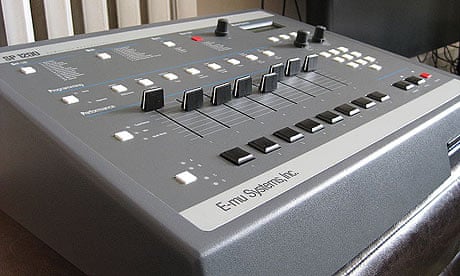What is it? A sampler, in ultra-simplistic terms, is basically a glorified tape recorder. Used primarily in electronic music, the sampler allows music to be made out of any sound recorded by the user, rather than relying on tones generated by oscillators, computer chips, white noise or other synthesiser technology.
Who uses it? Everyone! In electronic music, pop, and hip-hop the sampler is as important as the guitar is in rock. But Trevor Horn was the key architect in first incorporating sampling – via the Fairlight Computer Musical Instrument – into the language of pop.
How does it work? Instruments, or any other noises, can be recorded on to the hard drive of a sampler and then played back on a keyboard or other controller. The sampler can also re-pitch tones at the press of a key.
Where does it come from? The first instruments to experiment with sampling were "tape-replay keyboards". The first of these, the Chamberlin, was invented in the late 1940s, and involved a piano keyboard controlling a series of small tape decks, each holding eight seconds of recorded sound. In 1969 the BBC Radiophonic Workshop-affiliated inventor Peter Zinovieff developed the first digital sampler, the EMS Musys. The $300,000 Synclavier (1975) and the aforementioned light pen-operated Fairlight CMI (1979) brought samplers into recording studios. Classic samplers from E-mu Systems, Akai, and Roland in the 1980s made sampling technology available in homes.
Why is it classic? The possibilities of sampling – from realistic interpretations of other instruments, to manipulation of found sounds, to beat-looping – have touched all musical genres.
What's the best ever sampler song? It's a bit like saying, "What's the best ever song featuring a drum kit?" But if we're looking at the first "golden age" of sampling, then we'll have to go for the Art of Noise's Beat Box.
Five facts and things
In terms of who were the first musicians and producers to popularise sampling, EBN-OZN, Icehouse, Herbie Hancock, Thomas Dolby, Kate Bush, Peter Gabriel, Todd Rundgren and Duran Duran were the first in line to purchase the Fairlight – the first truly world-changing sampler.
Despite the light-years-ahead-of-his-time innovations of Harry Chamberlin, his tape-based sampling technology wouldn't be popularised until the late 60s and early 70s, via the similar Mellotron. It's psychedelic success was contentious, though – allegedly, Chamberlin's "window cleaner" in California took his blueprints overseas, selling the design without his knowledge to a Birmingham-based company that would manufacture the device as the Mellotron.
Sampling was crucial to the development of hip-hop, and it was one piece of kit in particular – the E-mu SP-1200, launched in 1987 – that lured hip-hop's rhythmic chassis away from the limitations of the DMX drum machine. Hank Shocklee, Prince Paul and the Beastie Boys were notable fans.
That first EMS contraption in 1969 ran on two early microcomputers – PDP-8s. These technological beasts harnessed the power of a whopping 12k RAM and a 32k hard drive. It's easy to laugh now, but that machine powered the world's first ever digital studio.
So what was the first record to make extensive use of sampling? Some have suggested it could be Stevie Wonder's Journey Through the Secret Life of Plants in 1979. Wonder used the Computer Music Melodian, another primitive PDP-8 machine, but one that could sync to ARP synthesisers and, like Hey What's That Sound's beloved Persephone, had an ace ribbon controller.
